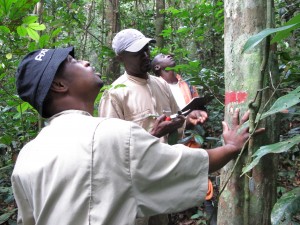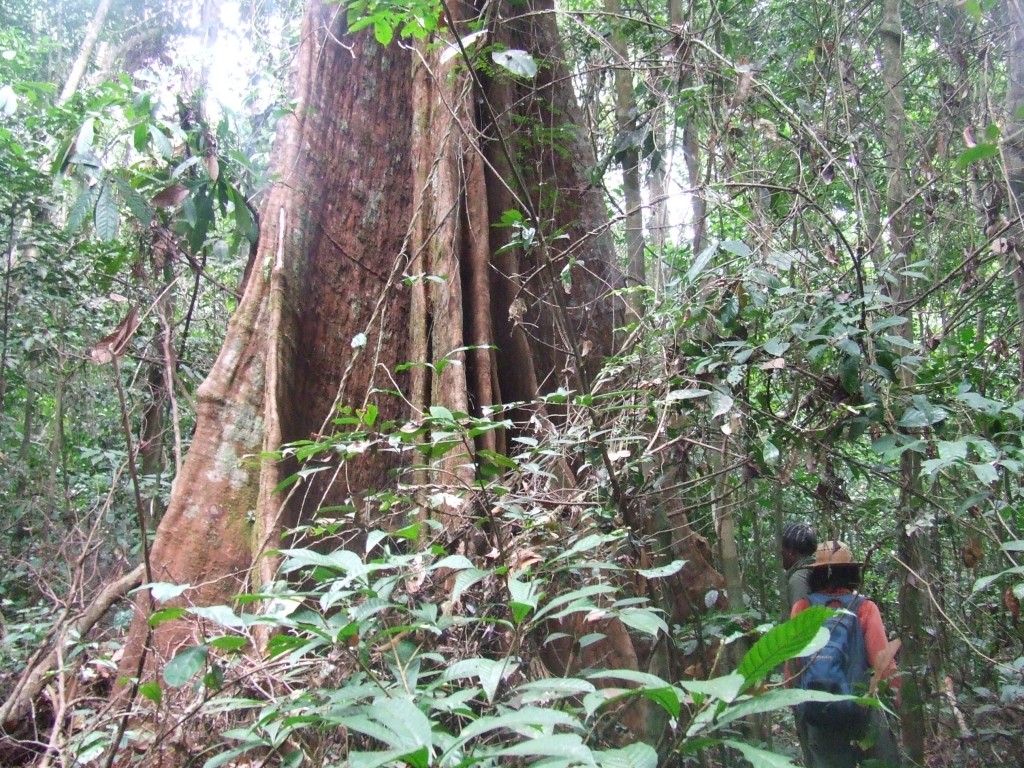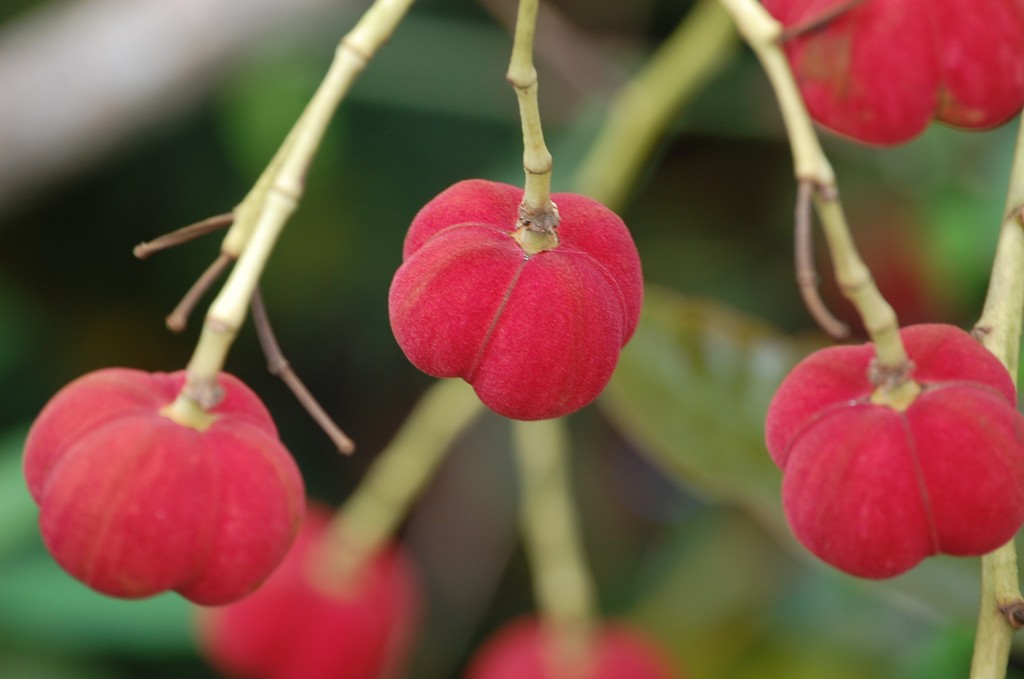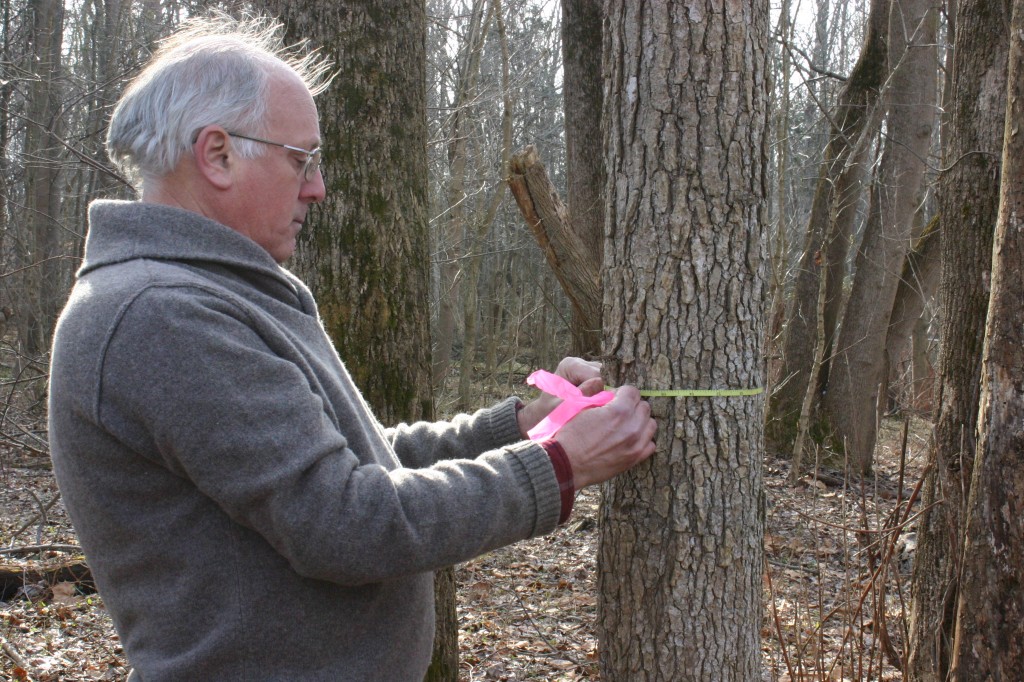by Kristen Minogue

Herve Memiaghe, front, in Gabon’s Rabi forest plot. The red line marks where they measure the tree’s diameter. (Smithsonian Institution)
Herve Memiaghe isn’t the average intern. Before coming to the Smithsonian Environmental Research Center, the 33-year-old Gabonese ecologist had already earned a master’s degree and spent four years working at IRET, the Institute for Research in Tropical Ecology in Gabon. Since 2012 he has also done field work in the Rabi plot as part of the Smithsonian’s global forest study.
The 25-hectare Rabi plot sits on the southwest coast of Gabon. Diversity spikes in the rainforests of Central Africa, where a single hectare can contain more than 400 different species. And that’s just the trees. The animals bring problems of their own. In Memiaghe’s experience, it’s not uncommon for hungry elephants to eat the tree tags along with the leaves.
“Sometimes we find the tag in the dung of elephants,” Memiaghe says. Usually the scientists can figure out where the tag came from, so it doesn’t throw off their research that much. “It just maybe can be a mess for the new people.”
He began working in Jess Parker’s forest plot at SERC in August. The opportunity first came through the National Museum of African Art. The Gabonese government had sponsored an exhibit called Earth Matters at the museum, and they included funding for a Gabonese scientist to come to the U.S. It was Lisa Korte, director of the Smithsonian’s Gabon Biodiversity Program, who tapped Memiaghe for the job.
“Gabon is a small country. There’s only 1.5 million people. There is a need for more Gabonese scientists,” she says. Meanwhile, Memiaghe had impressed her with his initiative and enthusiasm for conservation.
The Rabi plot, where Memiaghe worked in Gabon, and the 16-hectare SERC plot both belong to the Smithsonian’s ForestGEO network. ForestGEO (or Forest Global Earth Observatory) tracks how forests across the globe are responding to climate change. Researchers in Europe, Asia, Africa and the Americas take a “census” of the trees in their plots every five years, documenting their numbers, species and size.
For Memiaghe, the work of measuring tree growth was roughly the same, with one critical difference: In the Gabon plot, researchers measure trees by hand with a special tape measure for DBH (diameter at breast height). It’s not the most reliable technique. Not everyone is the same height. The bark can swell. And as a rule, the larger the margin of error, the larger the time scale scientists need to work with to compensate. In the case of tape measurements, the margin of error is so large researchers can only make measurements once every five years—hence the five-year census.
Parker uses a different method at SERC. Dendrometers, or metal tree bands, get fastened on once and expand with the tree. Afterward researchers can return and read the new measurements whenever they like—which is fantastic for droughts, shortening days and other seasonal shifts that can alter how a forest grows.
“We can figure out what the whole forest is doing on a weekly basis all year long,” Parker says. “He wants to try and do that, something like that, in Gabon. I don’t think anything like that’s ever been attempted in Africa.”
After his stint at SERC ended at the beginning of November, Memiaghe returned to the Rabi plot in Gabon. He hopes to come back to the U.S. to earn his Ph.D. But in the meantime, he plans to use the dendrometers in Gabon to begin annual measurements of tree growth, in addition to the five-year measurements already in place. Eventually he hopes to do comparisons of forest plots all across Central Africa.
Memiaghe isn’t the first intern Parker has hosted from the African continent. He noticed the same drive in one of his 2009 interns, Bertrand Tessa from Cameroon. “They’re very motivated to make something of this experience, not just to fill out a line on a resume. They want to make it turn into something useful.”




